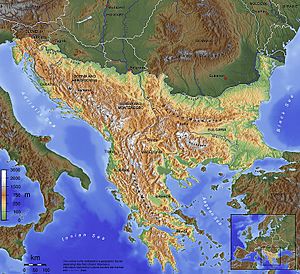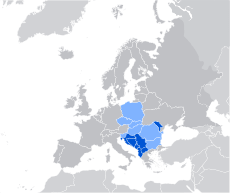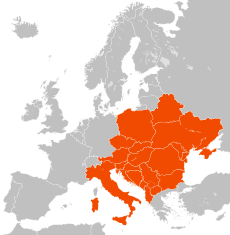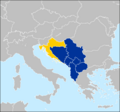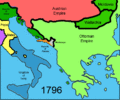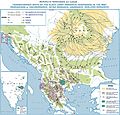Balkans facts for kids
The Balkans is a large area in Europe. It's like a big piece of land that sticks out into the sea, also known as a peninsula. This region covers about 550,000 square kilometers, which is a bit smaller than France. Around 55 million people live here. The name "Balkans" comes from the Balkan Mountains. These mountains run through the middle of Bulgaria and into eastern Serbia. They then continue to Slovenia as the Dinaric Alps.
Contents
What is the Balkans?
The word "Balkans" comes from the Turkish language. It means "chain of wooded mountains" or "swampy forest." This name describes the area well, as it has many mountains and forests.
Where are the Balkans?
The Balkans are surrounded by water on three sides. To the east, you'll find the Black Sea. To the south and west, there are parts of the Mediterranean Sea. These include the Adriatic Sea, Ionian Sea, Aegean Sea, and Sea of Marmara. To the north, the Balkan Peninsula is bordered by three important rivers: the Danube, Sava, and Krča rivers.
Countries in the Balkans
Many countries are part of the Balkan region. They include:
Some other countries are sometimes included because parts of them are in the region or they have strong connections:
Countries Connected to the Balkans
Some countries are not directly in the Balkans but are very close. They have played a big part in the region's history, culture, and politics. These include:
People and Religions
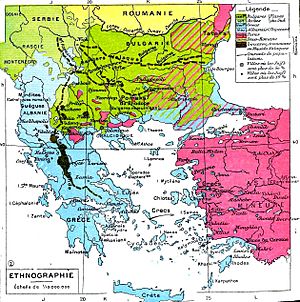
The Balkans is home to many different groups of people. Each group has its own culture and history. Some of the main groups include:
- Albanians (about 5 million people)
- Bosniaks (about 4.5 million people)
- Bulgarians (about 6.6 million people)
- Croats (about 4.5 million people)
- Greeks (about 10.7 million people)
- Macedonians (about 1.3 million people)
- Montenegrins (about 0.3 million people)
- Romanians (about 22 million people)
- Serbs (about 8 million people)
- Slovenes (about 2 million people)
- Turks (about 80 million people)
- There are also other groups like Roma, Gorani, Hungarians, and Czechs.
Religions in the Balkans
The most common religions in the Balkans are Christianity (especially Eastern Orthodox and Catholic) and Islam.
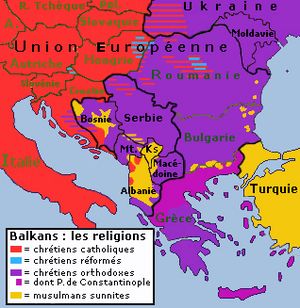
Eastern Orthodox Christianity is the main religion in these countries:
- Bulgaria (with the Bulgarian Orthodox Church)
- Greece (with the Greek Orthodox Church)
- Montenegro
- North Macedonia
- Romania (with the Romanian Orthodox Church)
- Serbia (with the Serbian Orthodox Church)
Roman Catholicism is the main religion in these countries:
- Croatia
- Slovenia
Islam is the main religion in these countries:
- Albania
- Turkey
Bosnia and Herzegovina is a special case. About half of the people are Muslim Bosniaks. Around 31% are Serbian Orthodox Christians. About 15% are Catholic Croats. This means that about 46% of the people are Christian. The rest follow other Christian groups, other religions, or no religion.
Images for kids
-
Western Balkan countries – Albania, Bosnia and Herzegovina, Croatia, Kosovo, Montenegro, North Macedonia, and Serbia. Croatia (yellow) joined the EU in 2013.
-
Panorama of the Balkan Mountains (Stara Planina). Its highest peak is Botev at a height of 2,376 m.
-
Sutjeska National Park contains Perućica, which is the largest primeval forests in the Balkans, and one of the last remaining in Europe.
-
Lake Skadar is the largest lake in the Balkans and Southern Europe.
-
Remnants of the Felix Romuliana Imperial Palace, a UNESCO World Heritage Site
-
Apollonia ruins near Fier, Albania
-
Hagia Sophia, built in sixth century Constantinople (now Istanbul, Turkey) as an Eastern Orthodox cathedral, later a mosque, then a museum, and now both a mosque and a museum
-
The 13th-century Church of St. John at Kaneo and the Ohrid Lake in North Macedonia. The lake and town were declared a World Heritage Site by UNESCO in 1980.
-
State entities on the former territory of Yugoslavia, 2008
-
Approximate distribution of religions in Albania
-
Transhumance ways of the Romance-speaking Vlach shepherds in the past
See also
 In Spanish: Península balcánica para niños
In Spanish: Península balcánica para niños


